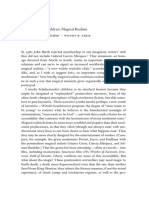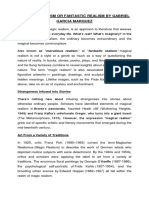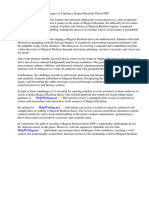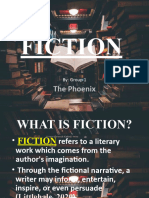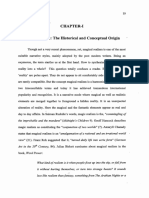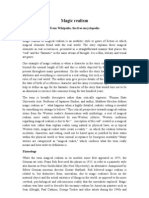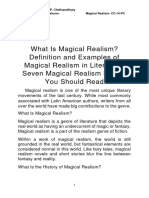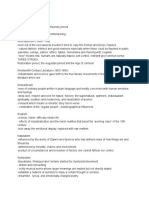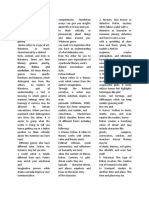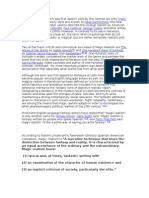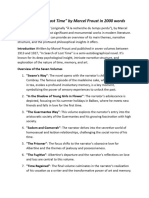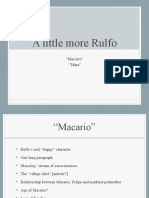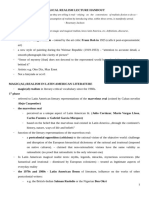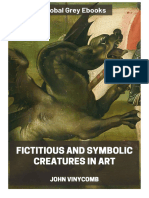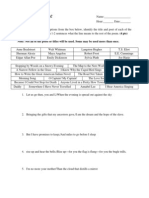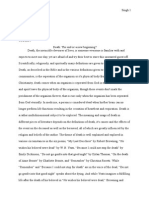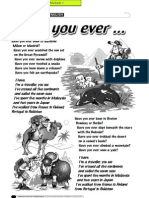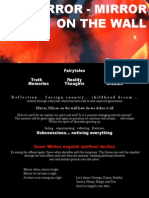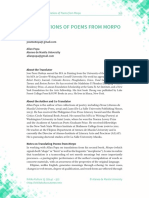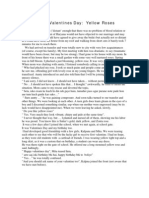0 ratings0% found this document useful (0 votes)
771 viewsMagical Realism - Article
Magical Realism - Article
Uploaded by
achiteneimariaThis document discusses the concept of magical realism including its origins, key features, and influences. It provides a detailed overview of magical realism including that it emerged in the 1920s, gained popularity in the 20th century due to factors like religious crisis and postmodernism exhausting inventive structures. It also examines the two main types of magical realism that developed in South America and Asia, and discusses influences on the style from genres like realism, Baroque, picaresque, Gothic, fable, and mythology. Key features of magical realism discussed include metaphors, hyperbole, mockery, and blending of realism with fantastic elements.
Copyright:
Attribution Non-Commercial (BY-NC)
Available Formats
Download as TXT, PDF, TXT or read online from Scribd
Magical Realism - Article
Magical Realism - Article
Uploaded by
achiteneimaria0 ratings0% found this document useful (0 votes)
771 views4 pagesThis document discusses the concept of magical realism including its origins, key features, and influences. It provides a detailed overview of magical realism including that it emerged in the 1920s, gained popularity in the 20th century due to factors like religious crisis and postmodernism exhausting inventive structures. It also examines the two main types of magical realism that developed in South America and Asia, and discusses influences on the style from genres like realism, Baroque, picaresque, Gothic, fable, and mythology. Key features of magical realism discussed include metaphors, hyperbole, mockery, and blending of realism with fantastic elements.
Original Description:
Definition, features, circumstances that led to the appearance of magical realism
Original Title
Magical realism -article
Copyright
© Attribution Non-Commercial (BY-NC)
Available Formats
TXT, PDF, TXT or read online from Scribd
Share this document
Did you find this document useful?
Is this content inappropriate?
This document discusses the concept of magical realism including its origins, key features, and influences. It provides a detailed overview of magical realism including that it emerged in the 1920s, gained popularity in the 20th century due to factors like religious crisis and postmodernism exhausting inventive structures. It also examines the two main types of magical realism that developed in South America and Asia, and discusses influences on the style from genres like realism, Baroque, picaresque, Gothic, fable, and mythology. Key features of magical realism discussed include metaphors, hyperbole, mockery, and blending of realism with fantastic elements.
Copyright:
Attribution Non-Commercial (BY-NC)
Available Formats
Download as TXT, PDF, TXT or read online from Scribd
Download as txt, pdf, or txt
0 ratings0% found this document useful (0 votes)
771 views4 pagesMagical Realism - Article
Magical Realism - Article
Uploaded by
achiteneimariaThis document discusses the concept of magical realism including its origins, key features, and influences. It provides a detailed overview of magical realism including that it emerged in the 1920s, gained popularity in the 20th century due to factors like religious crisis and postmodernism exhausting inventive structures. It also examines the two main types of magical realism that developed in South America and Asia, and discusses influences on the style from genres like realism, Baroque, picaresque, Gothic, fable, and mythology. Key features of magical realism discussed include metaphors, hyperbole, mockery, and blending of realism with fantastic elements.
Copyright:
Attribution Non-Commercial (BY-NC)
Available Formats
Download as TXT, PDF, TXT or read online from Scribd
Download as txt, pdf, or txt
You are on page 1of 4
MAGICAL REALISM:
CONCEPTS, FEATURES, PRINCIPLES AND METHODS
by Maria Achitenei
maria_achitenei@yahoo.com
T
he term “Magic Realism” was coined by Franz Roh who was referring to painting, a
nd by Massimo Bontempelli who was referring to his own writings, in the 1920ies.
It is a rich epic style characterised by the acceleration of the telling, the i
nsertion of the fictitional story into a chronicle in order to give the fantast
ic more credibility.
Slowly, it gained a lot of room in the world literary consciousness and it ap
pears that it will take a lot more than a vanguard current to replace it
I tried to enumerate several causes and conditions why magical realism broke
through the XXth century arts:
• The religious crisis: in the century of speed and great discoveries m
ankind doubted their ancestral feelings, starting to find something new or at le
ast to fill in the gaps of their knowledge about the creation of the world.
• The readers had got tired of introspection and psychological fight wit
hin the characters’ souls, so they were ready for a rich epic story which couldn
’t have been delivered but over wrapped in metaphors, hyperboles and wisdom.
• Postmodernism exhausted its well of inventing new structures because of
its lack of magic: Magical Realism filled up the gap between life and writing
with the premonition of a wonderful event.
• Magical Realism is an affective type current: it is using the deepest
roots of the human subconsciousness, assuming the ideological role that religi
on is on the verge of losing.
• The paradoxical growth of loneliness and alienation in the middle of a
more and more crowded world. Postmodernism is a cold current, an intellectual o
ne, which produces alienation; magical realism is displaying and making commo
n and ordinary all the worries previously introspected by Postmodernism.
• Magical Realistic prose moves the spirit through the old shapes, streng
thening their structures before stating them into life; it uses the free will w
ith all the respect it uses other features.
• Magical Realism appeared soon after the vanguard literary currents have
experienced new shapes in writing, and it took the advantage of melting everyth
ing and taking out only the methods it considered to be the most appropriate fo
r the novel.
• Magical Realism appeared as the natural step after the Beat culture had
discovered the happiness of simple things and had developed a taste for the epi
c stories full of metaphors, retold in the minstrel way.
• The reader was asking for something different, as realism and reality we
re sometimes too much to bear: so many people died, so the only way to face deat
h was to mock at him; this enhanced the need to read about hyperbolic deeds bel
onging to real characters, or, vice versa, about hyperbolic heroes in every da
y life. The reader needed the unforeseeable to invade his life and reinforce it
, as we all feel the need of miracles.
• Cyclically, people of the world create stories for the remembrance of th
eir heroes. Great people and countries created epic poems or odysseys in thei
r glory times; it’s now the small countries’ turn to show their talent in moder
n fairy tales within magical realism: the former colonists and colonies.
• The Magical Realistic style is designed by the language it is using, wi
th no boundaries at all, and it is due to the durational infinity of time and th
e isolated spaces delineated in metaphors.
I could identify some influences which represented the foundation of the magica
l realistic novels: realism, Baroque, Picaresque, Gothic, fable, tragedy, myths,
legends, homeland superstitions, allegory, social realism, parable, postmodern
ism.
From realism, the magical realistic style took the language transparency
, the pseudo objectivity, relying on the basis of the XXth century conventions.
A bitter metaphor about the exhausted realism is expressed by Salman R
ushdie in Midnight’s Children, where the waitresses, in keeping with the secrec
y of the club, are blind, as the clients didn’t want any eye witness for their d
ates:
"I saw her eyes were closed; unearthly, luminous eyes had been painted on her li
ds." (p. 541)
Realism is represented within the magical realistic style as fragmenta
l, but bits of realism can be recognised by the attentive reader:
-interior or exterior realism, based on details;
-familiar realism, which is distorted by magic realism through the inter
ference of slight differences from what we are familiar with;
-impressionist realism, which registers the perception, more than it ca
talogues details; also, its opposite, which puts details in order;
-pure realism, trying to catch an impossible absolute truth;
-social, revolutionary type realism;
-spiritual realism, referring to the ideas, feelings, vices and remorse
of the characters;
-cruel, childish realism, used by the writers to show the superiority o
f the good character.
Realism is not more democratic in ideas than other literary currents. But magica
l realism is: it builds imaginary democratic worlds that will represent for t
he reader the difficulty in adapting back to his/her day to day life. Myth will
help the magical realistic style to achieve a ritual touch..
Magical Realism branched up and we could consider two main types: the South A
merican one and the Asian one. It is their genetic dowry of mixed races and cul
tures that endowed them with such exploding imagination. At a deeper study, we’l
l notice that the South American novels are subjected to some influence, while
the Asian ones are subjected to other, although from the same root: all the m
agical realistic novels have been influenced by Baroque, but while Salman Rushd
ie’s novels are more like the Spanish Culteranism , which main features are: met
aphors, poetic language, antitheses of ideas and concepts, hyperboles, mytholog
ical motifs and sensorial type of descriptions(e.g.: using the colors etc),in Ga
rcía Márquez’s work we can easily observe some features developed from the Span
ish Conceptism: ingenuity, wits, humor, moral tendency.
The Baroque style was based on “theatricality metamorphosis, ostentation” and
“metaphorical wit essence”, but also “Mobility, fluidity, motion” and “interior
disintegration producing antitheses on all levels of existence”(Adrian Marino,
The Baroque, p.306). The literary thread is striving among ugly, bizarre, extra
vagant, false, ridiculous, shocking or touching details that are interwoven in
a mesmeric order to overwhelm the reader. Unlike other styles, whose descripti
on is full of dead metaphors, magical realism abounds in metaphors in a sequenc
e of events; its metaphors are sharp and alive, naive and live, ironical and hyp
erbolic, and they are underlining the super fluidity of the story. The hyperbat
on is used to emphasize the idea, to make it heavier with importance, and it co
nfers the text lyrical quality and musicality.
Malice is another feature of the Baroque and of magical realism too; it is base
d sometimes on multi-semantic phrases which give the narrative an illusion that
it is either comic or bloodcurdling. Then we can speak about comical disproporti
on,(originating in the absurd things), which does not want to make us laugh; it
’s a game of attracting absurdity and rejecting it as unsuitable. Mockery is of
ten used, though sometimes tragic:
“Clairvoyancy made it possible for him to arrest a future traitor before he co
mmited his act of treason”
(Salman Rushdie, Shame, Picador, London 1984,p.184)
Magical Realistic characters have slight features of a picaro: a pícaro is
“crafty, cunning, naughty, cheeky”(Oxford Dictionary). His life lacks the aspira
tion of a real hero. The magical realistic hero very often strives for life in
the same way.
The pícaro (like the magical realist hero Aadam Aziz) is such a hero made up by
the ambivalence of a lonely hero and of an anti hero, he is a temporary tramp s
earching for his luck by serving different masters, coloring his achievements w
ith tricks played on everybody, with a touch of cynical scorn for those who allo
w to be tricked; the story is always told in the first person singular with a sa
tire touch, as it was told by the first pícaro hero, Lazarillo de Tormes.
In Postmodernism, tricky metafiction arose bringing on stage the narrative qual
ities of the author– which is thought actually as a dialogue between the author
and the reader: Martin Amis’ own interview in his novel Money . It was time f
or the novel as a whole to become self aware.
While being quite a new technique –Sterne had tried it long before, Cervantes to
o, the readers were amazed, but soon afterwards they needed something richer – a
s an individual can live with no faith, but a group of people will always need s
ome moral pillars to rely on in their relationship with each other. When Postmod
ernism got to the verge of collapse, the authors rediscovered the rich stock of
Gothic, with freaks and monsters, incest and sexual violence, uncanny, decepti
ve weapons and they used all this material under the moral lights, for mockery.
Freaks now changed into fabulous heroes who can melt the crystals of the shop
s (Oskar Matzerath in The Tin Drum, by Günter Grass), or who can stop time when
they want or they can make it spin, like Ursula, in One Hundred Years of Sol
itude, by García Márquez.
Like the fable, the stories inside the magical realistic novel have morals, usua
lly stated previously, so that we can focus better. Magical realism uses the fab
le to enhance the moral value of the writing.
Magical Realism tries to individualize the moral failures of some social class,
or the strife of a nation in the narrator’s imaginary homeland; the narrator is
questioning historical events and ancient beliefs by presenting them using the
vocabulary and style of Bollywood films as in a parable; but when reading Salma
n Rushdie’s novels and running into the wide range of reference of west-east-eve
rywhere culture, the reader is mesmerised by the writer’s approach to each spa
rkling period of mankind culture. However, cultural reference is mixed up with
grotesqueries in all magical realistic authors. The style wouldn’t miss the da
rk sides of the human beings’ character, as on the whole it is a satire.
The montage technique: even if the name and description of a country, and other
details are taken from real life or the reality we are familiar with, at a cl
oser look we can notice many anomalies and anachronisms the reader is unaware of
while reading, and maybe he is not interested as he follows the story in the wa
y the narrator is telling it. The country may have features borrowed from diffe
rent times or even from other countries or simply they are imagined but given re
al names. Thus it quits being the real country and it starts being an imaginar
y one.
Magical realism is an attempt to overcome death and fate. A strong and overt ele
ment in the magical realism novels is the fact they do have the structure or
the elements of a tragedy:
-a crime is usually followed by another, of revenge;
-they have a choir who comment upon the characters’ acts;
-the writers use irony to stress the importance of death;
-the heroes are always characterized by their deeds;
-the ending is almost always catastrophic;
-the story is subjected to fate;
In magical realism, tragedy is more the imitation of the divine sacrifi
ce than the disastrous characters who suffered a decline of fortune and there’s
not enough space between them and the reader to intensify the myth. The presence
of death is not scary any more, death is an everyday presence and it is life it
self that acquires metaphysical values: death is not enough, so in the end of
the novel the whole literary universe blows up.(Shame, The Ground Beneath her Fe
et, by Salman Rushdie). In Midnight’s Children by Salman Rushdie the boatman, th
e mob and Padma have the choir part.
As a whole, magical realism treats the Gothic touch disrespectfully, which is, t
he authors use the techniques, but in a scornful way, mingled with the accelera
tion of the telling, which is a sine qua non condition for magical realism.
The writer uses either the unequal distribution of the novelistic attention or t
he monotonous tone in describing grotesqueries and touching scenes, thus giving
the reader the feeling that yes, they count the same for the story. Sometimes,
the narrator asks himself or the readers if what has happened is true or if the
action he witnessed was real (Sheherezade’s style).
The partial metaphor (or possessive metaphor), restricting all the narra
tive universe to its only existence, when reality is partially omitted, is use
d in the same way by all the writers, which is, stressing a recurrent happening
using the genitive:
“the veil of her solipsism” (Shame, by Salman Rushdie, p.209)
“The flint of his shame ignited the tinder of his pride”
(Shame, Salman Rushdie, p.189)
This kind of metaphor is a cheap one once taken out from the text, but
it is very suggestive within the text: it is strengthening the fate type unique
ness of the way the story is told, while we, the readers, are expecting/guessing
/imagining a second way.
“plague of shame” says Rushdie in Shame, “llaga del insomnio” s
ays Gabriel García Márquez in One Hundred Years of Solitude , sometimes using
the same syntagma.
More than the Latin American or other English writers, Rushdie uses a
lot of scientific hints, some of them the newest discoveries in the astronomic a
nd scientific fields: the rich cultural references amaze the readers and make
them believe the miracles Rushdie describes are true. We find out about black
holes, creation of the universe, shifting universes and others.
As the words fate or destiny are scarcely ever mentioned, it takes the reader
a lot of time to realize how deep and strong is this belief within the novel. Fr
om the moment the reader identifies the direction of the fate- flow in the novel
, he also notices it is the writing that imposes the rules, the sequence and ev
ents leads the writer, not vice versa, everything on the basis of his own rich
imagination and knowledge. When reading magical realistic novels the reader sus
pects permanently a double solution, but the text burns with the stiffness of
fate. Coincidence is linked to fate too: it occurs so often and somewhat rhyth
mically that the reader has the feeling of discovering the text in the pattern o
f a chess game or of a palimpsest.
Themes are very important in the magic realism and they are repeated ove
r and over, like patterns: e.g. alchemy and strange skills, Apocalyptic wind, cy
clical time, farcical tragedy, loneliness of the tyrants, Methuselah lives, twin
s, the author’s self portrayal as a scribbler in the novel, quixotic characters
, winged characters.. A theme that has been approached by the magical realist wr
iters is that of marvelous and unbelievable diseases: the Moor in The Moor’s L
ast Sigh by Salman Rushdie grows older twice the normal speed, Sallem’s father f
rom Midnight’s Children by Rushdie suffers from the disease of turning white,
the inhabitants of the village of Macondo, in One Hundred Years of Solitude by
G.G.Márquez suffer from the plague of oblivion.
The overcrowded earth is also a common theme for the magical realistic writers.
Thus, Nicanor Alvarado’s seven months born children in The Autumn of the Patria
rch, by G.G.Márquez are to be compared to the twins, triplets and quadruplets of
Talvar Ulhaq in Shame by Rushdie; all of them are conceived under the threat o
f the male’s authority or dictatorship.
If we try a definition of the style, this it will be:
Magical realism is a chronicle into which there are inserted the most fantastic
details and miracles worked by oddly gifted characters who are described by thei
r deeds in a highly accelerated epic of grotesqueries full of metaphors, hyperbo
le, scientific theories and poetic language.
You might also like
- Symposium - Marxism and FantasyDocument11 pagesSymposium - Marxism and FantasyLana StuparNo ratings yet
- Wendy.B.faris - The Question of The Other. Magical RealismDocument19 pagesWendy.B.faris - The Question of The Other. Magical RealismAlina Ciobotaru100% (1)
- văn học anh mỹ - bản hoàn chỉnhDocument20 pagesvăn học anh mỹ - bản hoàn chỉnhOh ShidNo ratings yet
- Schehrezad's Children-Magical Realism & Postmodern Fiction-Wendy B FarisDocument27 pagesSchehrezad's Children-Magical Realism & Postmodern Fiction-Wendy B FarisNadiaNo ratings yet
- Magic Realism Magic Realism (Or Magical Realism) Is An ArtisticDocument7 pagesMagic Realism Magic Realism (Or Magical Realism) Is An ArtisticRajamohanNo ratings yet
- Cot 2022 - 2023Document17 pagesCot 2022 - 2023John carlo PopaNo ratings yet
- Magic RealismDocument2 pagesMagic Realismyougova dreamNo ratings yet
- Magical Realism or Fantastic Realism by Gabriel Garcia MarquezDocument9 pagesMagical Realism or Fantastic Realism by Gabriel Garcia Marquezshahbaz0% (1)
- Magical Realism Thesis PDFDocument6 pagesMagical Realism Thesis PDFafknnkmeo100% (2)
- FICTION SHORTS NOTE BY YOGESH TIWARI_Document126 pagesFICTION SHORTS NOTE BY YOGESH TIWARI_Sateesh SarviNo ratings yet
- Fiction Wps OfficeDocument21 pagesFiction Wps OfficeFelyzia NiamhNo ratings yet
- 21st CenturyDocument6 pages21st CenturyRequiron FatimaNo ratings yet
- Fairy Tale Lecture IIDocument11 pagesFairy Tale Lecture IIsintamelya7No ratings yet
- 2 Половина 20века Лит-раDocument4 pages2 Половина 20века Лит-раVeronikaNo ratings yet
- Literary GenresDocument19 pagesLiterary Genressam RamirezNo ratings yet
- Gothic Versus RomanticDocument21 pagesGothic Versus RomanticMomina ButtNo ratings yet
- Martin Amis - Time - S ArrowDocument2 pagesMartin Amis - Time - S ArrowAndrea MarTen33% (3)
- 100 Years of Solitude - Marquez - Reading Postcolonial TextDocument4 pages100 Years of Solitude - Marquez - Reading Postcolonial TextemasumiyatNo ratings yet
- 07 Chapter 2Document41 pages07 Chapter 2Mehboob Subhan QadiriNo ratings yet
- Salman Rushdie:" A Metafiction With A Difference "Document4 pagesSalman Rushdie:" A Metafiction With A Difference "Karanam Ramachandra RaoNo ratings yet
- The Literary Review: ContentsDocument11 pagesThe Literary Review: Contentssiwar mNo ratings yet
- Magic RealismDocument14 pagesMagic Realismpapa_23No ratings yet
- 0013 Extended Essay M20Document17 pages0013 Extended Essay M20milaperez21No ratings yet
- Short Story + Novel + Literary CriticismDocument6 pagesShort Story + Novel + Literary CriticismramshaNo ratings yet
- Romance As A Genre: Amlit - Lecture NotesDocument2 pagesRomance As A Genre: Amlit - Lecture NotesN.C.No ratings yet
- Romance As A Genre: Amlit - Lecture NotesDocument2 pagesRomance As A Genre: Amlit - Lecture NotesIuliana FlorinaNo ratings yet
- Self-Directed Learning Activity Sheet in Creative NonfictionDocument5 pagesSelf-Directed Learning Activity Sheet in Creative Nonfictionsuper novaNo ratings yet
- IJCRT1133360Document10 pagesIJCRT1133360chinmayNo ratings yet
- What Is Magical RealismDocument5 pagesWhat Is Magical RealismMohammad Asraful Omar FahimNo ratings yet
- Lit100 Prelims ReviewerDocument8 pagesLit100 Prelims ReviewerIngried Alexia DiazNo ratings yet
- The Umbilical Connect Between Nature and Narrative Parismita Singh'sDocument6 pagesThe Umbilical Connect Between Nature and Narrative Parismita Singh'sLinuxMachineNo ratings yet
- 6 PDFDocument10 pages6 PDFNagina SabaNo ratings yet
- Magic Realism ThesisDocument4 pagesMagic Realism Thesisdwnt5e3k100% (2)
- It Is True That Magical Realism Is A Combinition Between Magic and Reality But It Is A Branch of Serious Fiction That Never Be Escapist or SpeculativeDocument3 pagesIt Is True That Magical Realism Is A Combinition Between Magic and Reality But It Is A Branch of Serious Fiction That Never Be Escapist or Speculativeberrebah yasminaNo ratings yet
- Realism DefinitionDocument6 pagesRealism DefinitionFaisal JahangeerNo ratings yet
- Creative Nonfiction #1Document50 pagesCreative Nonfiction #1Marie CuachinNo ratings yet
- Literary GenresDocument4 pagesLiterary GenresJhamae Rose AbulogNo ratings yet
- EnglishDocument6 pagesEnglishLalein VillodresNo ratings yet
- Creative Nonfiction Lessons 2022Document6 pagesCreative Nonfiction Lessons 2022MA.RESA M.GALIDONo ratings yet
- Magic RealismDocument2 pagesMagic RealismassignhelpNo ratings yet
- In Search of Lost Time in 2000 WordsDocument4 pagesIn Search of Lost Time in 2000 Wordsandrewholly999No ratings yet
- A Little More Rulfo: "Macario" "Talpa"Document12 pagesA Little More Rulfo: "Macario" "Talpa"lzeeNo ratings yet
- Magic RealismDocument7 pagesMagic RealismAdinanCDNo ratings yet
- World Literature ReviewerDocument29 pagesWorld Literature ReviewerMark Jayson AgaoNo ratings yet
- Mag AssignmentDocument6 pagesMag AssignmentShahid AshrafNo ratings yet
- Contemporary LiteratureDocument4 pagesContemporary LiteratureMaricar RamosNo ratings yet
- NOVELSDocument5 pagesNOVELSCherrie Lynn LumanangNo ratings yet
- Introduction To Gothic LiteratureDocument13 pagesIntroduction To Gothic LiteraturePrachi PhartiyalNo ratings yet
- Alchemist Paulo CoelhoDocument19 pagesAlchemist Paulo Coelhomanikandankumar000No ratings yet
- 4. Postmodernism Magical Realism Lecture OutlineDocument5 pages4. Postmodernism Magical Realism Lecture OutlineSylvia Julia VojarNo ratings yet
- EL117 Handouts (Arciga)Document4 pagesEL117 Handouts (Arciga)Rhea Mae ArcigaNo ratings yet
- Fabulation & MetafictionDocument15 pagesFabulation & MetafictionGerico FernandezNo ratings yet
- Master Slave DialecticDocument13 pagesMaster Slave DialecticphoedratinaNo ratings yet
- Magic Realism DissertationDocument5 pagesMagic Realism DissertationWriteMyPaperPleaseUK100% (1)
- Moth Smoke by Mohsin HamidDocument9 pagesMoth Smoke by Mohsin HamidRita KNo ratings yet
- Magic RealismDocument3 pagesMagic RealismgangagopefraudNo ratings yet
- Gothic Horror and Children's BooksDocument17 pagesGothic Horror and Children's Booksdona100% (1)
- John Vinycomb Fictitious and Symbolic Creatures in ArtDocument143 pagesJohn Vinycomb Fictitious and Symbolic Creatures in ArtMárcio CelsoNo ratings yet
- BARRIOS - Jason Renz 2nd Minor Paper PDFDocument2 pagesBARRIOS - Jason Renz 2nd Minor Paper PDFJ Renz BarriosNo ratings yet
- Ancient Book WritersDocument2 pagesAncient Book WritersDeepika KanoriaNo ratings yet
- Unit TestDocument4 pagesUnit Testapi-242414642No ratings yet
- A Rose For EmilyDocument11 pagesA Rose For EmilyNikki OlivaNo ratings yet
- Song of The SA ManDocument2 pagesSong of The SA ManSouravNo ratings yet
- Sri Isopanisad Original 1969 Edition SCANDocument138 pagesSri Isopanisad Original 1969 Edition SCANPaulo VictorNo ratings yet
- Arts Week 6Document4 pagesArts Week 6Cess BuanNo ratings yet
- Edexcel IGCSE English Literature Coursework 2014Document9 pagesEdexcel IGCSE English Literature Coursework 2014sonal116No ratings yet
- Haveyou Ever BeenDocument3 pagesHaveyou Ever BeenGerwilmot0% (1)
- Monkeys Paw Essay Example Phase 2Document1 pageMonkeys Paw Essay Example Phase 2api-254633946No ratings yet
- The Book of Repulsive WomenDocument24 pagesThe Book of Repulsive WomenDiego Núñez GonzálezNo ratings yet
- Thomas BrowneDocument12 pagesThomas BrowneYims HectorNo ratings yet
- Year 8 Unreliable Narrators - Creative Writing UbdDocument18 pagesYear 8 Unreliable Narrators - Creative Writing Ubdapi-313814787No ratings yet
- WCW Poem Seng 252Document11 pagesWCW Poem Seng 252Alexandra Marguerite CurdNo ratings yet
- I 7 Orality and Oral TheoryDocument22 pagesI 7 Orality and Oral TheoryFrankly CHRIST MinistryNo ratings yet
- Troll Shane KoyczenDocument2 pagesTroll Shane Koyczenaidanchiu29No ratings yet
- Grammatical EquivalenceDocument6 pagesGrammatical Equivalencestartime15No ratings yet
- Exploring Prose: AssignmentDocument18 pagesExploring Prose: AssignmentYogeshwari SookharryNo ratings yet
- ReflectionDocument2 pagesReflectionapi-241694247No ratings yet
- Final Exam XI-English - 134Document3 pagesFinal Exam XI-English - 134DhruvNo ratings yet
- Pound's Modernism: A Sequel in HistoryDocument19 pagesPound's Modernism: A Sequel in HistoryQismet RustemovNo ratings yet
- Translations of Poems From Morpo: Jose Perez Beduya Allan Popa Ateneo de Manila UniversityDocument14 pagesTranslations of Poems From Morpo: Jose Perez Beduya Allan Popa Ateneo de Manila UniversityAna SaladagaNo ratings yet
- Arns & Sasse - Subversive AffirmationDocument6 pagesArns & Sasse - Subversive AffirmationIGBDNo ratings yet
- PoemsDocument313 pagesPoemsHarith NaharNo ratings yet
- Yellow Roses (Happy Valentines Day)Document13 pagesYellow Roses (Happy Valentines Day)Arindam MitraNo ratings yet
- Still I Rise by Maya AngelouDocument7 pagesStill I Rise by Maya AngelouVishalValmikiNo ratings yet
- AthenaDocument22 pagesAthenaCharmaine TejadaNo ratings yet
- Poeytry 2Document8 pagesPoeytry 2Ilaf Aziz AminNo ratings yet
- 298-303 Niyati KabthiyalDocument6 pages298-303 Niyati KabthiyalviaNo ratings yet
- The Forgotten HermitageDocument75 pagesThe Forgotten Hermitagemusic2850No ratings yet



